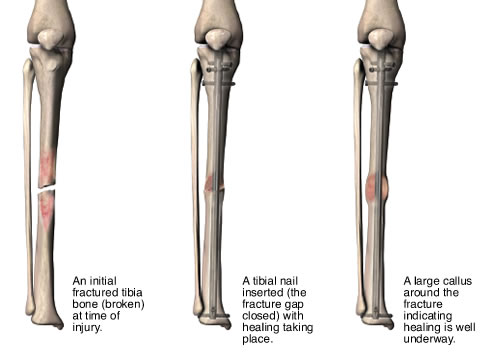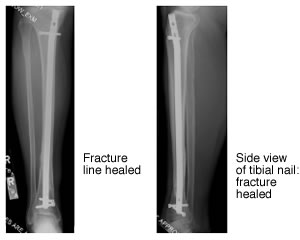Advanced Care for Broken Bones
More than likely, you’re already familiar with the non-surgical approaches that physicians use to help fractures heal. A doctor applies casts, braces, or splints around the affected area in order to hold the broken bone securely in position and provide support while the body repairs itself. In some cases however, particularly fractures of the long bones, today’s best orthopaedic treatment includes securing the fracture internally with a metal intramedullary nail implanted by surgical procedure.
Your doctor has provided you with this booklet to answer some of the questions you may have about your broken bone and fracture treatment. It will also help you better understand what to typically expect over the next few days and weeks as you leave the hospital, begin physical therapy and follow up with your orthopaedic surgeon and physical therapist.
What is an Intramedullary Nail?
To align the fractured bones and provide optimal healing support, the orthopaedic surgeon makes a small incision through the skin and tissue closest to one end of the broken bones. The surgeon then inserts a small rod-like nail device into the hollow center of the bone, called the medullary cavity. The intramedullary nail forms a self-contained internal splint to stabilize the fracture. This is often done for fractures of the tibia (see below), femur (thigh), and humerus (shoulder).
Potential Advantages of the Intramedullary Nail
- Provides durable, strong and flexible support.
- Allows more exact alignment of the fractured bones for faster healing and may lead to earlier weightbearing.1
- May lead to earlier joint motion for reduced stiffness.1
- Encourages more natural-like motion in uninjured muscles and neighboring joints.

In the Hospital, What Now?
 Together, you and your orthopaedic surgeon will decide on a course of aftercare that’s most appropriate for you. The full length of your care may span several months. Rehabilitation will begin in the hospital and continue with outpatient physical therapy sessions, as well as at home. Understanding your care may help you feel more comfortable throughout the healing process.
Together, you and your orthopaedic surgeon will decide on a course of aftercare that’s most appropriate for you. The full length of your care may span several months. Rehabilitation will begin in the hospital and continue with outpatient physical therapy sessions, as well as at home. Understanding your care may help you feel more comfortable throughout the healing process.
How do I care for the new incision sites?
At first, a hospital medical professional will take care of your incision sites. Like any other wound, they must be cared for every day to avoid complications that may include infection. As your health allows, you will probably learn how to care for the incision sites yourself.
The steps required to care for your wounds at home are described on page 3 within the section “At Home. Where Do I Go from Here?”
Why take additional X-rays?
Following surgery, your surgeon will take X-rays every few weeks to confirm that the fracture is healing appropriately. Keep in mind that everyone heals differently. You will heal at your own pace based upon a number of factors that your surgeon can discuss with you. Your surgeon will keep you informed about your progress each step of the way.
How does physical therapy help me heal?
Since motion and muscle strength play an important role in fracture healing, the right exercises can significantly aid in your recovery. Of course, the fracture itself may hinder the use of your injured limb. Your doctor’s choice of an intramedullary nail gives you the potential to begin moving earlier than treatment with an external cast or brace.
A physical therapist will work closely with you to select the most appropriate treatment and exercises to help you restore your range of motion and rebuild muscle strength.
At Home, Where Do I Go from Here?
Prior to being discharged, be sure to ask for an at-home recovery plan. Should you have questions later, contact your surgeon directly. The information that follows can help you make a smooth transition home while your fracture heals.
How do I care for the healing incision sites?
You may find it helpful to enlist the support of a friend or family member while you adjust to caring for yourself at home. You will need clean gauze pads or a clean cloth, plain soap, clean water, clean towels and a shower or hand sprayer to clean and protect your incision sites while they heal. Most patients prefer using the shower in the bathroom, but you will use a location where you feel the most secure and have access to a faucet sprayer or spray bottle.
This is what your doctor will typically advise:
- Spread all of your supplies on a clean towel for easy access.
- Either sit on a stool in the shower or use the spray faucet or spray bottle in the sink.
- Wash your hands.
- Remove the bandages from the incision sites.
- Gently wipe away any dried blood with a saline-moistened gauze pad.
- Inspect the sites for signs of infection such as redness, excessive or prolonged drainage, or pus. It’s normal to see some clear and/or blood-tinged drainage in the first few days after surgery while the incision is closing.
- Place a fresh, dry dressing on the site and secure it.
- Once the incision has closed and all drainage stops, the bandages do not have to be replaced and the incision site can remain open to the air.
- Wet the incision sites with clean lukewarm water.
- Clean the sites with soap and water using a gauze pad or clean cloth.
- Remove any “crusty” material from the wound.
- Wash everything again.
- Dry the skin with a clean towel or gauze.
- Let any remaining secretions dry.
- If the site is still draining, place a clean, dry gauze pad over the site and secure it.
What precautions should I take?
Although your bone is not fully healed and you should keep your surgeon’s precautions in mind — like avoiding activities that could cause a fall — your doctor will likely advise you to engage in as much normal movement as possible. Your physician will advise you based on your injury and recovery. Remember the instructions from your orthopaedic surgeon with regard to mobilization, weightbearing and physical therapy.
Further Precautions Your Surgeon Will Likely Give:
- Be careful with stairs, rugs and loose shoelaces.
- Avoid contact with animals.
- Avoid contact with dust and dirt.
- Avoid unnecessary handling of your incision sites.
What if I suspect a skin infection?
Even if you follow all the precautions, the skin around the incision sites may become infected. Symptoms of infection include local reddening and/or swelling of the skin, pain and fever. If these symptoms progress, contact your physician. You may require oral antibiotics to control the infection.
Will your nail be removed?
In general, after a year the soft tissues improve and the fracture heals enough that your orthopaedic surgeon may remove the intramedullary nail.When your doctor decides the time is right, the nail may be removed in either an outpatient or day surgery center. Following removal of your intramedullary nail, you’ll need to care for the incision sites just as you did when the nail was implanted.
For more information, contact your physician.
Reference:
1. Thomas Mueckley, Oliver Gonschorek, and Volker Buehren, “Compression Nailing of Long Bones,” European Journal of Trauma, 2003; 29:113-28.